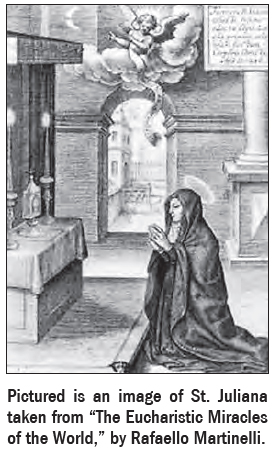How the Feast of Corpus Christi Came About
By Sean M. Wright
 Jacques Pantaléon, a humble cobbler’s son, was sent to a monastery school where he excelled in canon and common law studies.
Jacques Pantaléon, a humble cobbler’s son, was sent to a monastery school where he excelled in canon and common law studies.
Pantaléon was serving as archdeacon of the cathedral of Liège in Belgium when the visions of Sister, later Saint, Juliana, prioress of the Norbertine canonesses, became known to Robert de Thourotte, Bishop of Liège.
In her vision, Sister Juliana saw a black stripe diagonally laid across the surface of the moon. Jesus explained the darkness as symbolizing the absence of a feast day wholly dedicated to adoration of and thanksgiving for his Real, Abiding, Eucharist Presence.
 Jesus’ request was certainly timely.
Jesus’ request was certainly timely.
In his tract, “On the Body and Blood of the Lord” (831), St. Paschasius Radbertus taught how bread and wine become substantially different at the Consecration, without quite coining the word “transubstantiation.” That was left to Hildebert of Lavardin, c.1179, Archbishop of Tours, and one of the greatest hymnologists of the Middle Ages.
“Transubstantiation,” the term used to describe the miracle of the Mass, was dogmatically defined in 1215 by Pope Innocent III and the bishops of the 4th Lateran Ecumenical Council.
With an armload of theologians all warmly endorsing the idea, in 1246 de Thourotte became the first bishop to celebrate the Feast of Corpus Christi. Homes and shops in his diocese were colorfully decorated. Flower girls strewed petals on the processional path, acolytes carried torches and swung incense thuribles before the bishop walking under a canopy held steady by local nobility. Wrapped in his finest cope and humeral veil, Bishop de Thourotte held aloft the Eucharistic Jesus in a monstrance for all to see, genuflect before, and adore. Other bishops soon followed this pattern for their own dioceses.
The beauty of this feast was not lost on the cobbler’s son, later consecrated Bishop of Verdun and, afterward, Latin Patriarch of Jerusalem. When Alexander IV died, the eight cardinals left to elect the next pope refused to vote for each other, so they looked elsewhere. Pantaléon was elected Peter’s successor in 1261, taking the name Urban IV.
In August 1264, Urban issued the bull, “Transiturus de Hoc Mundo” establishing Corpus Christi as a “feast of precept” — one taking precedence over any other liturgical celebration. Its Mass was assigned to the Thursday following Trinity Sunday.
This was the first time a pope had ever imposed a feast to be observed by the Universal Church (In 1969, Pope St. Paul VI permitted episcopal conferences the option to celebrate Corpus Christi on the first Sunday after Trinity Sunday).
With memories of Sister Juliana’s vision and Bishop de Thourotte’s celebrations, Pope Urban explained the purpose of the feast was to rekindle love, encourage faith, halt the spread of heresy, and to atone for blasphemy. Mostly, however he wanted to honor the Most Blessed Sacrament more joyfully than on Holy Thursday, tinged as it is with the sadness of Good Friday.
Now the pope needed the proper and readings for the Corpus Christi Mass, along with prayers and hymns for the Office i.e., the day’s canonical hours. He asked the great theologian and masterful poet, Friar Thomas Aquinas of the Dominican Order. Immensely grateful for the assignment, Thomas immediately set to work.
Not one to put all his eggs in one basket, however, Urban thought it best to hedge his bet. He asked Friar Bonaventure, another notable theologian and General Minister of the Franciscan Order, to do the same. Bonaventure was equally enthusiastic.
The future saints were good friends and, some while later, Bonaventure took his complet-ed manuscript across town to Thomas’ priory to show his friend what he considered a superbly sublime work. Only then did the two friars discover they’d been given the same task. Thomas was nearing completion as well.
Bonaventure, so the story goes, asked to look at some of what Thomas had completed. After reading several parchment sheets on which Aquinas had written his Mass Proper, Vespers, Matins and so forth, Bonaventure sighed and tossed his own completed manuscript into the nearby fireplace saying, “Thomas, I would not want it on my conscience that I stood between the world and what you have written.”
Magnanimity is another mark of holiness.
Sean M. Wright, MA, is a Master Catechist for the Archdiocese of Los Angeles and a member of the RCIA team at Our Lady of Perpetual Help parish in Santa Clarita. An Emmy nominee, he answers comments at Locksley69@aol.com.
729